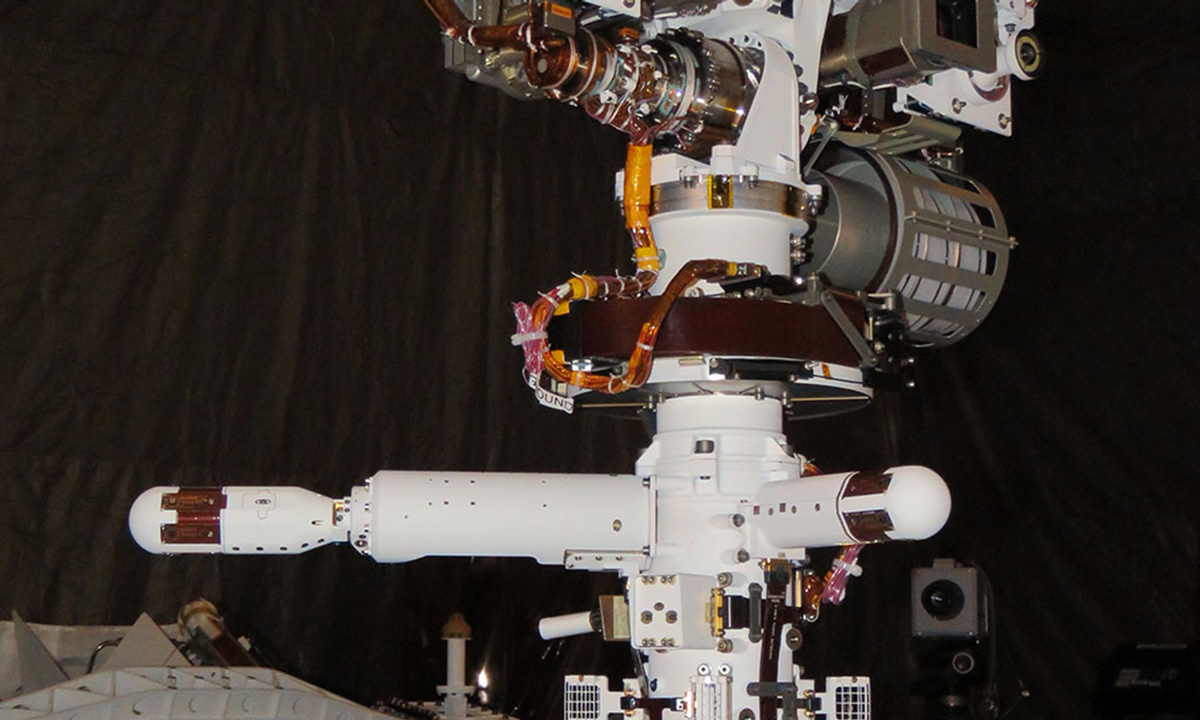




La stazione ambientale MEDA installata sul rover Perseverance
Credit: NASA/JPL-Caltech.
The Mars Environmental Dynamics Analyzer (MEDA) collects atmospheric measurements that will provide a regular weather report from Jezero Crater on Mars. Each of two horizontal booms mounted on the Mars 2020 rover's mast is encircled by six wind detectors, which will measure the horizontal and vertical winds. Because they extend away from the rover, they avoid wind interference caused by the rover itself and record the wind speed from any direction. Below the two wind sensor booms are three temperature sensors, which in combination with two more placed at the rover body, will measure the ambient temperature near the surface. Near the temperature sensors, other sensors will measure the relative humidity of the atmosphere, and the balance between the amount of infrared energy received from the sun and the amount reflected back to space.
The term "SOL" refers to the length of the solar day on Mars that is: 24 hours, 39 minutes end 35,244 seconds. The number that is reported in the field is the number of Martians days since Curiosity is on Mars. A martian year is di 668.6 sols. Martian months are defined as spanning 30 degrees in solar longitude (Ls).
Due to the eccentricity of Mars orbit, martian months are thus from 46 to 67 sols long.
|
Month
number |
Ls range (degrees) |
Sol range |
Duration (in sols) |
Seasons |
||
| 1 | 0 | 30 | 0.0 | 61.2 | 61.2 | Northern Hemisphere Spring Equinox at Ls=0 |
| 2 | 30 | 60 | 61.2 | 126.6 | 65.4 | |
| 3 | 60 | 90 | 126.6 | 193.3 | 66.7 | Aphelion (largest Sun-Mars distance) at Ls=71 |
| 4 | 90 | 120 | 193.3 | 257.8 | 64.5 | Northern Hemisphere Summer Solstice at Ls=90 |
| 5 | 120 | 150 | 257.8 | 317.5 | 59.7 | |
| 6 | 150 | 180 | 317.5 | 371.9 | 54.4 | |
| 7 | 180 | 210 | 371.9 | 421.6 | 49.7 |
Northern Hemisphere Autumn Equinox at Ls=180 Dust Storm Season begins |
| 8 | 210 | 240 | 421.6 | 468.5 | 46.9 | Dust Storm Season |
| 9 | 240 | 270 | 468.5 | 514.6 | 46.1 |
Perihelion (smallest sun-Mars distance) at Ls=251 Dust Storm Season |
| 10 | 270 | 300 | 514.6 | 562.0 | 47.4 |
Northern hemisphere Winter Solstice at Ls=270 Dust Storm Season |
| 11 | 300 | 330 | 562.0 | 612.9 | 50.9 | Dust Storm Season |
| 12 | 330 | 360 | 612.9 | 668.6 | 55.7 | Dust Storm Season ends |
